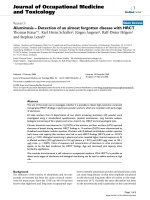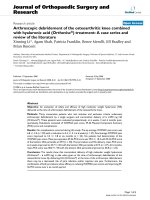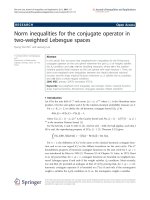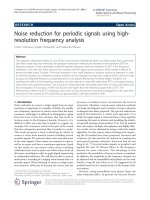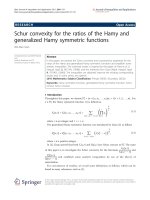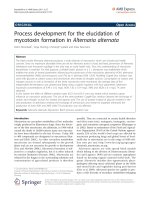Báo cáo hóa học: "WEIGHT CHARACTERIZATIONS FOR THE DISCRETE HARDY INEQUALITY WITH KERNEL" pot
Bạn đang xem bản rút gọn của tài liệu. Xem và tải ngay bản đầy đủ của tài liệu tại đây (547.43 KB, 14 trang )
WEIGHT CHARACTERIZATIONS FOR THE DISCRETE HARDY
INEQUALITY WITH KERNEL
CHRISTOPHER A. OKPOTI, LARS-ERIK PERSSON, AND ANNA WEDESTIG
Received 16 August 2005; Accepted 17 August 2005
A discrete Hardy-type inequality (
∞
n=1
(
n
k
=1
d
n,k
a
k
)
q
u
n
)
1/q
≤ C(
∞
n=1
a
p
n
v
n
)
1/p
is consid-
ered for a positive “kernel” d
={d
n,k
}, n,k ∈ Z
+
,andp ≤ q. For kernels of product type
some scales of weight characterizations of the inequality are proved with the correspond-
ing estimates of the best constant C.Asufficient condition for the inequality to hold i n
the general case is proved and this condition is necessary in special cases. Moreover, some
corresponding results for the case when
{a
n
}
∞
n=1
are replaced by the nonincreasing se-
quences
{a
∗
n
}
∞
n=1
are proved and discussed in the light of some other recent results of this
type.
Copyright © 2006 Christopher A. Okpoti et al. This is an open access article distributed
under the Creative Commons Attribution License, which permits unrestricted use, dis-
tribution, and reproduction in any medium, provided the original work is properly cited.
1. Introduction
Let us consider the following special case of an interesting result in [4](seealso[5]) by
Gol’dman.
Theorem 1.1. Let 0 <r
≤ p ≤ q<∞, σ = pr/(p − r) (for p = r, σ =∞). Then the
inequality
∞
n=1
n
k=1
a
k
ϕ
k
r
q/r
u
q
n
1/q
≤ C
∞
n=1
a
n
v
n
p
1/p
(1.1)
for three weight sequences
{ϕ
n
}, {u
n
},and{v
n
} (n = 1,2, ) holds if and only if the (Muck-
enhoupt type) condition
B
G
:= sup
n≥1
n
k=1
ϕ
k
v
−1
k
σ
1/σ
∞
k=n
u
q
k
1/q
< ∞. (1.2)
It holds with the usual maximum interpretation for the case p
= r (σ =∞).
Hindawi Publishing Corporation
Journal of Inequalities and Applications
Volume 2006, Article ID 18030, Pages 1–14
DOI 10.1155/JIA/2006/18030
2 Hardy’s inequality
Moreover, for the best constant C in (1.1), C
≈ B
G
(but without explicitly specifying the
equivalence constants).
In this paper we will prove a result (see Corollary 3.3) showing that the Gol’dman
condition (1.2) in fact can be replaced by some scales of conditions and also the estimate
C
≈ B
G
can be given in a much more precise form.
Partly guided by the development in the continuous case (see [6] and the literature
therein) we will study the general inequality
∞
n=1
n
k=1
d
n,k
a
k
q
u
n
1/q
≤ C
∞
n=1
a
p
n
v
n
1/p
,1<p≤ q<∞, (1.3)
with a general kernel d
={d
n,k
}
∞
n,k=1
, d
n,k
≥ 0, involved.
We note that the first contribution in this direction was due to Andersen and Heinig
[1, Theorem 4.1], who proved a sufficient condition for (1.3) to hold for the case 1
≤ p ≤
q<∞ with special nonnegative kernels {d
n,k
}
∞
n,k=1
that was assumed to be nonincreasing
in k and nondecreasing in n.
In this paper, using the result in [8] (see Proposition 2.2),wewillprovesomescalesof
characterizations for the special case with product weight kernel d
n,k
= l
n
h
k
, n,k = 1,2,
(see Theorem 3.1). Moreover, we will prove a sufficient condition also for the general case
with an arbit rary nonnegative kernel (see Theorem 3.7), which at least for a special case
is also necessar y (see Remark 3.8).
Finally, partly guided by recent results by Sinnamon [12] (see also [11]), we will prove
the surprising fact that we get the same characterizations in our Proposition 2.2 when
restricting the set of positive sequences
{a
n
}
∞
n=1
to the cone of nonincreasing sequences
if, in addition, the weight sequence
{v
n
} is nonincreasing (see Theorem 3.9).
The paper is organised as follows: in order not to disturb our discussions later on
we present some preliminaries in Section 2. T he main results together with some related
remarks are presented in Section 3 and the proofs are given in Section 4.Finally,some
concluding remarks and open questions can be found in Section 5.
2. Preliminaries
In this paper
{a
n
}
∞
n=1
denotes an arbitrary (weight) sequence of nonnegative numbers.
Moreover ,
{u
n
}
∞
n=1
, {v
n
}
∞
n=1
, {l
n
}
∞
n=1
,and{h
k
}
∞
k=1
denote fixed weight sequences and d =
{
d
n,k
}
∞
n,k=1
is a nonnegative discrete kernel, that is, a sequence of nonnegative numbers.
We will need the following technical lemma.
Lemma 2.1. Let A
k
=
k
n
=1
a
n
, A
0
= 0 and, for n = 1,2, , let a
n
> 0.
(a) If 0 <λ<1, then, for k
= 1,2, ,
λA
λ−1
k
a
k
≤ A
λ
k
− A
λ
k
−1
≤ λA
λ−1
k
−1
a
k
. (2.1)
Christopher A. Okpoti et al. 3
(b) If λ<0 or λ>1, then, for k
= 1,2, ,
λA
λ−1
k
−1
a
k
≤ A
λ
k
− A
λ
k
−1
≤ λA
λ−1
k
a
k
. (2.2)
Proof. The proof follows by using the mean value theorem in an appropriate way; for
details see [8].
Recently Sinnamon [12] proved a remarkable result, which, in particular, means that
some Hardy-type inequalities for nonincreasing sequences in fact are equivalent to the
corresponding Hardy-type inequalities for general nonnegative sequences. Hence, they
can be characterized by the same condition(s); see the books [6, 9]butalsothemore
recent results, for example, in [10, 13, 14]. Here we also mention the following special
case of a recent result in [8] (see also [7]), which we w ill need later on.
Proposition 2.2. Let 1 <p
≤ q<∞. Then the inequality
∞
n=1
n
k=1
a
k
q
u
n
1/q
≤ C
∞
n=1
a
p
n
v
n
1/p
(2.3)
holds if and only if
A
1
(s):= sup
N≥1
N
n=1
v
1−p
n
s
⎛
⎝
∞
n=N
u
n
n
k=1
v
1−p
k
q(1/p
−s)
⎞
⎠
1/q
< ∞, (2.4)
for some s,0<s
≤ 1/p
,or
A
2
(s):= sup
N≥1
N
n=1
v
1−p
n
−s
⎛
⎝
N
n=1
u
k
n
k=1
v
1−p
k
q(1/p
+s)
⎞
⎠
1/q
< ∞, (2.5)
for some s, 0 <s
≤ 1/p,or
A
3
(s):= sup
N≥1
∞
n=N
u
n
s
⎛
⎝
N
n=1
v
1−p
n
∞
k=n
u
k
p
(1/q−s)
⎞
⎠
1/p
< ∞, (2.6)
for some s, 0 <s
≤ 1/q,or
A
4
(s):= sup
N≥1
∞
n=N
u
n
−s
⎛
⎝
∞
n=N
v
1−p
n
∞
k=n
u
k
p
(1/q+s)
⎞
⎠
1/p
< ∞, (2.7)
for some s, 0 <s
≤ 1/q
.
4 Hardy’s inequality
Moreover, for the best constant C in (2.3), the following estimates hold:
sup
0<s<1/p
ps
ps +1
1/p
A
1
(s) ≤ C ≤ inf
0<s<1/p
A
1
(s)
p − 1
p(1 − s) − 1
1/p
, (2.8)
sup
0<s<1/p
(ps)
1/p
A
2
(s) ≤ C ≤
1
(p − 1)
1/q
q − p
pβ
p/(q − p), p(q − 1)/(q − p)
(q−p)/pq
A
2
1
p
(2.9)
if p<qand
A
2
1
p
≤
C ≤ p
A
2
1
p
(2.10)
if p
= q,
sup
0<s<1/q
q
s
q
s +1
1/q
A
3
(s) ≤ C ≤ inf
0<s<1/q
A
3
(s)
q
− 1
q
(1 − s) − 1
1/q
, (2.11)
sup
0<s<1/q
(q
s)
1/q
A
4
(s)
≤ C ≤ (q − 1)
1/p
q − p
(p − 1)qβ
q/(q − p),q(p − 1)/(q − p)
(q−p)/pq
A
4
1
q
(2.12)
if p<qand
A
4
1
q
≤
C ≤ pA
4
1
q
(2.13)
if p
= q.
Remark 2.3. (a) The conditions A
3
(s) < ∞ and A
4
(s) < ∞ are just the natural duals of the
conditions A
1
(s) < ∞ and A
2
(s) < ∞, respectively (cf. [6]).
(b) It is pointed out in [8] that as endpoint cases of some of the conditions above we
just obtain some well-known conditions by Bennett (see [2, 3]).
3. Main results
First we state the following generalization and unification of Theorem 1.1 and Proposi-
tion 2.2.
Christopher A. Okpoti et al. 5
Theorem 3.1. Let 1 <p
≤ q<∞ and consider the kernel d ={d
n,k
}
∞
n,k=1
, where d
n,k
= l
n
h
k
,
n,k
= 1,2, Then the inequality
∞
n=1
n
k=1
d
n,k
a
k
q
u
n
1/q
≤ C
∞
n=1
a
p
n
v
n
1/p
(3.1)
holds if and only if
D
1
(s):= sup
N≥1
N
n=1
h
p
n
v
1−p
n
s
⎛
⎝
∞
n=N
l
q
n
u
n
n
k=1
h
p
k
v
1−p
k
q(1/p
−s)
⎞
⎠
1/q
< ∞, (3.2)
for some s, 0 <s
≤ 1/p
,or
D
2
(s):= sup
N≥1
N
n=1
h
p
n
v
1−p
n
−s
⎛
⎝
N
n=1
l
q
n
u
n
n
k=1
h
p
k
v
1−p
k
q(1/p
+s)
⎞
⎠
1/q
< ∞, (3.3)
for some s,0<s
≤ 1/p,or
D
3
(s):= sup
N≥1
∞
n=N
l
q
n
u
n
s
⎛
⎝
N
n=1
h
p
n
v
1−p
n
∞
k=n
l
q
k
u
k
p
(1/q−s)
⎞
⎠
1/p
< ∞, (3.4)
for some s,0<s
≤ 1/q,or
D
4
(s):= sup
N≥1
∞
n=N
l
q
n
u
n
−s
⎛
⎝
∞
n=N
h
p
n
v
1−p
n
∞
k=n
l
q
k
u
k
p
(1/q+s)
⎞
⎠
1/p
< ∞, (3.5)
for some s,0<s
≤ 1/q
.
Moreover, for the best constant C in (3.1), the following estimates hold:
sup
0<s<1/p
ps
ps +1
1/p
D
1
(s) ≤ C ≤ inf
0<s<1/p
D
1
(s)
p − 1
p(1 − s) − 1
1/p
, (3.6)
sup
0<s<1/p
(ps)
1/p
D
2
(s) ≤ C ≤
1
(p − 1)
1/q
q − p
pβ
p/(q − p), p(q − 1)/(q − p)
(q−p)/pq
D
2
1
p
(3.7)
if p<qand
D
2
1
p
≤
C ≤ p
D
2
1
p
(3.8)
6 Hardy’s inequality
if p
= q,
sup
0<s<1/q
q
s
q
s +1
1/q
D
3
(s) ≤ C ≤ inf
0<s<1/q
D
3
(s)
q
− 1
q
(1 − s) − 1
1/q
, (3.9)
sup
0<s<1/q
(q
s)
1/q
D
4
(s)
≤ C ≤ (q − 1)
1/p
q − p
(p − 1)qβ
q/(q − p),q(p − 1)/(q − p)
(q−p)/pq
D
4
1
q
,
(3.10)
if p<qand
D
4
1
q
≤
C ≤ pD
4
1
q
(3.11)
if p
= q.
Remark 3.2. For the case d
≡{1} we obtain Proposition 2.2 and we can also derive the
following more precise version of Theorem 1.1.
Corollary 3.3. Let 0 <r
≤ p ≤ q<∞ and σ = pr/(p − r) (for p = r, σ =∞). Then the
inequality (1.1)holdsifandonlyif
B
1
(s) = sup
N≥1
N
n=1
ϕ
n
v
−1
n
σ
s/r
⎛
⎝
∞
n=N
u
q
n
n
k=1
ϕ
k
v
−1
k
σ
(q/r)(r/σ−s)
⎞
⎠
1/q
< ∞, (3.12)
for some s, 0 <s
≤ (r/σ).
Moreover, for the best constant C in (1.1), the following estimates hold:
sup
0<s<r/σ
ps
ps + r
1/p
B
1
(s) ≤ C ≤ inf
0<s<r/σ
p − r
p
1 − s) − r
1/σ
B
1
(s). (3.13)
Remark 3.4. If s
= r/σ in (3.12), then we have
B
1
r
σ
=
sup
n≥1
n
k=1
ϕ
k
v
−1
k
σ
1/σ
∞
k=n
u
q
k
1/q
< ∞, (3.14)
which coincides with (1.2) (i.e., B
1
(r/σ) = B
G
) and the statement in Theorem 1.1 follows.
Remark 3.5. Remark 3.4 means that the scale of conditions in Corollary 3.3 has the
Gol’dman condition in its right endpoint. However, there exist also other scales of condi-
tions of completely different types for characterizing (1.1). See [7], our Remark 5.5,and
Example 5.6.
Christopher A. Okpoti et al. 7
Remark 3.6. When r
= 1andϕ
k
= 1, k = 1,2, ,inCorollary 3.3, then the inequality
(1.1)withv
n
replaced by v
1/p
n
and u
n
replaced by u
1/q
n
coincides with (2.3). In particular,
for the case s
= 1/p
in (3.12), we have
B
1
1
p
=
sup
n≥1
n
k=1
v
1−p
k
1/p
∞
k=n
u
k
1/q
< ∞, (3.15)
which coincides with Muckenhoupt’s condition A
1
(1/p
) < ∞ (cf. (2.4) and also Bennett
[2]).
Next we state the following result for the case with a general kernel.
Theorem 3.7. Let 1 <p
≤ q<∞. If
E(s):
= sup
N≥1
N
n=1
v
1−p
n
s
⎛
⎝
∞
n=N
d
q
n,k
u
n
n
m=1
v
1−p
m
q(1/p
−s)
⎞
⎠
1/q
< ∞ (3.16)
holds for some s
∈ (0,1/p
), then the inequality (1.3)holdswith
C
≤ inf
0<s<1/p
p − 1
p − sp− 1
1/p
E(s). (3.17)
Remark 3.8. For the case d
n,k
= 1, n,k = 1,2, , the condition (3.16) coincides with the
condition (2.4) and, thus, according to Proposition 2.2, in this case the condition (3.16)
is both necessar y and sufficient for the inequality (1.3)tohold.
Inspired by a recent result of Sinnamon [12], we also state the following.
Theorem 3.9. Let 1 <p
≤ q<∞. Then the inequality
∞
n=1
n
k=1
a
∗
k
q
u
n
1/q
≤ C
∞
n=1
a
∗
n
p
v
n
1/p
(3.18)
holds for all nonincreasing sequences
{a
∗
n
}
∞
n=1
w ith the additional condition that {v
n
}
∞
n=1
is
nonincreasing if and only if the condition (2.4) holds. Moreover, for the best constant C in
(3.18), the estimate (2.8)holds.
Remark 3.10. For the case v
n
= 1, n = 1,2, , the statement in Theorem 3.9 is a special
case of a recent remarkable result of Sinnamon [12, pages 300–301].
4. Proofs
Proof of Theorem 3.1. With the kernel
{d
n,k
}={l
n
h
k
} the inequalit y (3.1)becomes
∞
n=1
n
k=1
l
n
h
k
a
k
q
u
n
1/q
≤ C
∞
n=1
a
p
n
v
n
1/p
, (4.1)
8 Hardy’s inequality
that is,
∞
n=1
n
k=1
h
k
a
k
q
l
q
n
u
n
1/q
≤ C
∞
n=1
a
p
n
v
n
1/p
. (4.2)
We now put b
k
= h
k
a
k
in the inequalit y (4.2) and note that (4.2)isequivalentto
∞
n=1
n
k=1
b
k
q
l
q
n
u
n
1/q
≤ C
∞
n=1
b
p
n
h
−p
n
v
n
1/p
. (4.3)
Considering l
q
n
u
n
=
u
n
and h
−p
n
v
n
=
v
n
to be our new fixed nonnegative weight sequences,
we have that the inequalit y
∞
n=1
n
k=1
b
k
q
u
n
1/q
≤ C
∞
n=1
b
p
n
v
n
1/p
(4.4)
is equivalent to the Hardy-type inequality (2.3). Thus, by replacing u
n
by l
q
n
u
n
and v
n
by h
−p
n
v
n
in the conditions (2.4)–(2.7) (i.e., those described by A
1
(s)–A
4
(s)) and using
Proposition 2.2, we obtain that the conditions (3.2)–(3.5) (i.e., those described by D
1
(s)–
D
4
(s)) are necessary and sufficient conditions for (4.4), and, thus, (3.1)tohold.Sub-
sequently, by replacing A
i
(s)withD
i
(s), i = 1, ,4, respectively, in the estimates (2.8)–
(2.2), we obtain the estimates for the best constant C in (3.1) to be those described in
(3.6)–(3.10). The proof is complete.
Proof of Corollary 3.3. In the inequality (3.1)withd
n,k
= l
n
h
k
,weleth
k
= ϕ
r
k
and let l
n
=
u
(qr−1)/q
n
and replace a
n
with a
r
n
and v
n
with v
pr
n
:
∞
n=1
n
k=1
ϕ
r
k
a
r
k
q
u
qr
n
1/q
≤ C
∞
n=1
a
pr
n
v
pr
n
1/p
. (4.5)
Moreover , replace p with p/r and q with q/r, and we obtain
∞
n=1
n
k=1
ϕ
r
k
a
r
k
q/r
u
q
n
1/q
≤ C
o
∞
n=1
a
p
n
v
p
n
1/p
, (4.6)
with C
o
= C
1/r
which is equivalent to the inequality (1.1).
This means that for the case 0 <r<p
≤ q<∞, we can characterize the inequality (1.1)
by using Theorem 3.1. Thus, in condition (3.2)wefirstletl
n
= u
(qr−1)/q
n
, h
n
= ϕ
r
n
, v
n
= v
pr
n
,
after that replace p by p/r and q by q/r, and finally raise the condition to the power 1/r.
Christopher A. Okpoti et al. 9
Hence, by Theorem 3.1, we conclude that the condition (3.12) (i.e., that described by
B
1
(s)) characterizes (1.1). Moreover, the estimate (3.13) follows in a similar way from the
estimate (3.6). The proof is complete.
Proof of Theorem 3.7. Put b
p
n
= a
p
n
v
n
in (1.3). Then (1.3)isequivalentto
∞
n=1
n
k=1
d
n,k
b
k
v
−1/p
k
q
u
n
1/q
≤ C
∞
n=1
b
p
n
1/p
. (4.7)
Assume that the condition (3.16)holdsandlet
V
n
=
n
k=1
v
1−p
k
. (4.8)
Applying H
¨
older’s inequality, Lemma 2.1(a) with a
k
= v
1−p
k
(0 <λ= (p − sp − 1)/(p −
1) < 1), and Minkowski’s inequality to the left-hand side of (4.7), we find that
∞
n=1
n
k=1
d
n,k
b
k
v
−1/p
k
q
u
n
1/q
=
∞
n=1
n
k=1
d
n,k
b
k
V
s
k
V
−s
k
v
−1/p
k
q
u
n
1/q
≤
∞
n=1
n
k=1
d
p
n,k
b
p
k
V
sp
k
q/p
n
k=1
V
−sp
k
v
−p
/p
k
q/p
u
n
1/q
=
∞
n=1
n
k=1
d
p
n,k
b
p
k
V
sp
k
q/p
n
k=1
V
−sp/(p−1)
k
v
1−p
k
q/p
u
n
1/q
≤
p − 1
p − sp− 1
1/p
∞
n=1
n
k=1
d
p
n,k
b
p
k
V
sp
k
q/p
V
q((p−sp−1)/p)
n
u
n
1/q
≤
p − 1
p − sp− 1
1/p
∞
k=1
b
p
k
V
sp
k
∞
n=k
d
q
n,k
V
q(1/p
−s)
n
u
n
p/q
1/p
≤
p − 1
p − sp− 1
1/p
sup
k≥1
V
s
k
∞
n=k
d
q
n,k
V
q(1/p
−s)
n
u
n
1/q
∞
k=1
b
p
k
1/p
.
(4.9)
Hence, (4.7), and, thus, (1.3) hold. By taking infimum over s
∈ (0,1/p
), we find that also
(3.17)holds.Theproofiscomplete.
Proof of Theorem 3.9
Sufficiency. TheprooffollowsbyjustusingProposition 2.2 in the present situation and
also the upper estimate in (2.8) is obtained. However, here we make the following inde-
pendent proof.
10 Hardy’s inequality
Assume that the condition (2.4)holdsandlet
{a
∗
n
}
∞
n=1
be an arbitrary nonincreasing
sequence and define a
∗
n
= (
∞
m=n
t
m
)
1/p
, n = 1, 2, The inequality (3.18) can equiva-
lently be rewritten as
∞
n=1
n
k=1
∞
m=k
t
m
1/p
q
u
n
1/q
≤ C
∞
n=1
∞
m=n
t
m
v
n
1/p
= C
∞
m=1
t
m
m
n=1
v
n
1/p
.
(4.10)
Takin g V
n
as it is defined in (4.8) and applying H
¨
older’s inequality, Lemma 2.1(a) (with
λ
= (p − sp− 1)/(p − 1)), Minkowski’s inequality, and changing the order of the summa-
tion to the left-hand side of (4.10), we have that
∞
n=1
n
k=1
∞
m=k
t
m
1/p
q
u
n
1/q
=
∞
n=1
n
k=1
∞
m=k
t
m
1/p
V
s
k
V
−s
k
v
1/p
k
v
−1/p
k
q
u
n
1/q
≤
∞
n=1
n
k=1
∞
m=k
t
m
V
sp
k
v
k
q/p
n
k=1
V
−sp/(p−1)
k
v
1−p
k
q/p
u
n
1/q
≤
p − 1
p − sp− 1
1/p
∞
n=1
n
k=1
∞
m=k
t
m
V
sp
k
v
k
q/p
V
q(p−sp−1)/p
n
u
n
1/q
≤
p − 1
p − sp− 1
1/p
∞
k=1
∞
m=k
t
m
V
sp
k
v
k
∞
n=k
V
q(p−sp−1)/p
n
u
n
p/q
1/p
=
p − 1
p − sp− 1
1/p
∞
m=1
t
m
m
k=1
v
k
V
sp
k
∞
n=k
V
q(1/p
−s)
n
u
n
p/q
1/p
≤
p − 1
p − sp− 1
1/p
sup
k≥1
V
s
k
∞
n=k
V
q(1/p
−s)
n
u
n
1/q
∞
m=1
t
m
m
k=1
v
k
1/p
.
(4.11)
Hence, by taking infimum over s
∈ (0,1/p
), (4.10), and thus, (3.18) hold with a constant
C satisfying the right-hand inequality in (2.8).
Necessity. Assume that (3.18) holds and for fixed N
∈ Z
+
apply the following test se-
quence:
a
∗
k
=
⎧
⎪
⎨
⎪
⎩
V
−((1+ps)/p)
N
v
1−p
k
for k = 1, ,N,
V
−((1+ps)/p)
k
v
1−p
k
for k = N +1,
(4.12)
to (3.18). (Note that with our assumptions
{a
∗
k
}
∞
k=1
is a nonincreasing sequence.)
Christopher A. Okpoti et al. 11
For the left-hand side of (3.18)wehavethat
∞
n=1
n
k=1
a
∗
k
q
u
n
1/q
=
∞
n=1
N
k=1
V
−((1+ps)/p)
N
v
1−p
k
+
n
k=N+1
V
−((1+ps)/p)
k
v
1−p
k
q
u
n
1/q
≥
∞
n=N
N
k=1
V
−((1+ps)/p)
N
v
1−p
k
+
n
k=N+1
V
−((1+ps)/p)
k
v
1−p
k
q
u
n
1/q
≥
∞
n=N
V
1/p
−s
N
+ V
−(1+ps)/p
n
n
k=N+1
v
1−p
k
q
u
n
1/q
=
∞
n=N
V
1/p
−s
N
+ V
−(1+ps)/p
n
V
n
− V
N
q
u
n
1/q
≥
∞
n=N
V
1/p
−s
N
+ V
1/p
−s
n
− V
−(1+ps)/p
N
V
N
q
u
n
1/q
=
∞
n=N
V
q(1/p
−s)
n
u
n
1/q
.
(4.13)
For the right-hand side of (3.18), by applying Lemma 2.1(b) we find that
∞
n=1
a
∗
n
p
v
n
1/p
=
N
n=1
V
−(1+ps)
N
v
1−p
k
+
∞
n=N+1
V
−(1+ps)
k
v
1−p
k
1/p
≤
V
−ps
N
+
1
ps
V
−ps
N
1/p
≤
1+
1
ps
1/p
V
−s
N
=
ps +1
ps
1/p
V
−s
N
.
(4.14)
Combining (4.14), (4.13), and (3.18)wehavethat
∞
n=N
V
q(1/p
−s)
n
u
n
1/q
≤ C
ps +1
ps
1/p
V
−s
N
, (4.15)
that is, that
ps
ps +1
1/p
V
s
N
∞
n=N
V
q(1/p
−s)
n
u
n
1/q
≤ C<∞. (4.16)
12 Hardy’s inequality
Hence, by taking supremum over N
≥ 1 and supremum over s ∈ (0,1/p
), we conclude
that (2.4) and the left-hand side of the estimate (2.8)hold.
Summing up, we have proved that (3.18)isequivalentto(2.4) and that (2.8)holds.
The proof is complete.
5. Concluding remarks
By comparing the statements in Theorem 3.7 and Remark 3.8 and the corresponding
knowledge from the continuous case (see [6]), it is natural to raise the following question.
Open question 5.1. Find necessary and sufficient conditions for (1.3) to hold for all n on-
negative sequences
{a
n
}
∞
n=1
for as general kernels as possible.
Remark 5.2. For the case v
n
= 1, n = 1,2, Proposition 2.2 holds also if the set of all
weight sequences
{a
n
}
∞
n=1
is restricted to the cone of all nonincreasing weig ht sequences
{a
∗
n
}
∞
n=1
(cf. also Remark 3.10). This fact follows from a recent result of Sinnamon [12].
Remark 5.3. The result of Sinnamon [12] was recently generalized by Persson et al. [11]
to a more general case involving kernels and general measures. However, these kernels
still have some restrictions (monotonicity in the second variable). These results make it
natural to also raise the following question.
Open question 5.4. Find necessary and sufficient conditions for (1.3) to hold on the cone
of nonincreasing sequences for as general kernels as possible.
Remark 5.5. The statement in Corollary 3.3 follows by using just the conditions (3.2)and
(3.6)inTheorem 3.1. By using the other (equivalent) conditions, we can obtain other
scales of conditions for characterizing (1.1). See [7]; here we just give the follow ing ex-
ample.
Example 5.6. Let 0 <r
≤ p ≤ q<∞ and σ = pr/(p − r)(forp = r, σ =∞). Then the
inequality (1.1) holds if and only if
B
2
(s) = sup
N≥1
N
n=1
ϕ
n
v
−1
n
σ
−s/r
⎛
⎝
∞
n=N
u
q
n
n
k=1
ϕ
k
v
−1
k
σ
(q/r)(r/σ+s)
⎞
⎠
1/q
< ∞, (5.1)
for some s,0<s
≤ r/p.
Moreover, for the best constant C in (1.1) we have the following estimates:
sup
0<s<r/p
p
r
s
1/p
B
2
(s) ≤ C ≤
σ
p
1/q
q − p
pβ(p/(q − p), p(q − r)/r(q − p))
(q−p)/pq
B
2
r
p
(5.2)
Christopher A. Okpoti et al. 13
if p<qand
B
2
r
p
≤
C ≤
p
p − r
B
2
r
p
(5.3)
if p
= q.
Remark 5.7. In [4, 5 ] by Gol’dman the case p>qwas also treated and the results in this
paper indicate that the results of Gol’dman can be generalized in a similar way also for
this case. We aim to return to this question in a forthcoming paper.
Acknowledgment
We thank Professor Saburoh Saitoh for some generous suggestions which have improved
the final version of this paper.
References
[1] K. F. Andersen and H. P. Heinig, Weighted norm inequalities for certain integral operators,SIAM
Journal on Mathematical Analysis 14 (1983), no. 4, 834–844.
[2] G. Bennett, Some elementary inequalities, The Quarterly Journal of Mathematics. Oxford. Sec-
ond Series 38 (1987), no. 152, 401–425.
[3]
, Some elementary inequalities. III, The Quarterly Journal of Mathematics. Oxford. Sec-
ond Series 42 (1991), no. 166, 149–174.
[4] M. L. Gol’dman, Hardy type inequalities on the cone of quasi-monotone functions, Research report
98/31, Russian Academy of Sciences Far-Eastern Branch Computer Center, Khabarovsk, 1998,
70 pages.
[5]
, Estimates for the norms of integral and discrete operators of Hardy type on cones of quasi-
monotone functions, Doklady Akademii Nauk 377 (2001), no. 6, 733–738 (Russian).
[6] A. Kufner and L E. Persson, Weighted Inequalities of Hardy Ty pe, World Scientific, New Jersey,
2003.
[7] C.A.Okpoti,Weight characterization of discrete Hardy and Carleman type inequalities, Licentiate
thesis, Department of Mathematics, Lule
˚
a University of Technology, Lule
˚
a, 2005, in print.
[8] C. A. Okpoti, L E. Persson, and A. Wedestig, Scales of weight characterizations for the discrete
Hardy and Carleman inequalities, Proceedings of Function Spaces, Differential Operators and
Nonlinear Analysis (FSDONA ’04), Academy of Sciences of the Czech Republic, Milovy, 2004,
pp. 236–258.
[9] B. Opic and A. Kufner, Hardy-Type Inequalities, Pitman Research Notes in Mathematics Series,
vol. 219, Longman Scientific & Technical, Harlow, 1990.
[10] L E. Persson and V. D. Stepanov, Weighted integral inequalities with the geometric mean operator,
Journal of Inequalities and Applications 7 (2002), no. 5, 727–746, an abbreviated version can
also be found in Russian Academy of Sciences. Doklady. Mathematics 63 (2001), 201–202.
[11] L E. Persson, V. D. Stepanov, and E. P. Ushakova, Equivalence of Hardy-type inequalities with
general measures on the cones of non-negative respective non-increasing functions, to appear in
Proceedings of the American Mathematical Society.
[12] G. Sinnamon, Hardy’s inequality and monotonicity, Proceedings of Function Spaces, D ifferential
Operators and Nonlinear Analysis (FSDONA ’04), Academy of Sciences of the Czech Republic,
Milovy, 2004, pp. 292–310.
[13] A. Wedestig, Some new Hardy type inequalities and their limiting inequalities,JIPAM.Journalof
Inequalities in Pure and Applied Mathematics 4 (2003), no. 3, 15, article 61.
14 Hardy’s inequality
[14] , Weighted inequalities of Hardy-type and their limiting inequalities, Ph.D. thesis, Depart-
ment of Mathematics, Lule
˚
a University of Technology, Lule
˚
a, 2003, 106 pages.
Christopher A. Okpoti: Department of Mathematics, Lule
˚
a University of Technology,
971 87 Lule
˚
a, Sweden
E-mail address:
Lars-Erik Persson: Department of Mathematics, Lule
˚
a University of Technology,
971 87 Lule
˚
a, Sweden
E-mail address:
Anna Wedestig: Department of Mathematics, Lule
˚
a University of Technology,
971 87 Lule
˚
a, Sweden
E-mail address:
